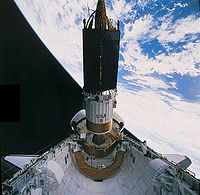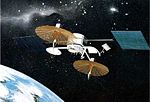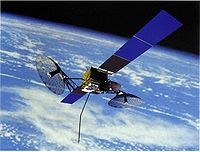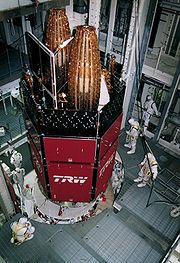
TDRS
Encyclopedia




Communications satellite
A communications satellite is an artificial satellite stationed in space for the purpose of telecommunications...
that forms part of the Tracking and Data Relay Satellite System (TDRSS) used by NASA
NASA
The National Aeronautics and Space Administration is the agency of the United States government that is responsible for the nation's civilian space program and for aeronautics and aerospace research...
and other United States
United States
The United States of America is a federal constitutional republic comprising fifty states and a federal district...
government agencies for communications to and from independent "User Platforms" such as satellites, balloons, aircraft, and the International Space Station
International Space Station
The International Space Station is a habitable, artificial satellite in low Earth orbit. The ISS follows the Salyut, Almaz, Cosmos, Skylab, and Mir space stations, as the 11th space station launched, not including the Genesis I and II prototypes...
. This system was designed to replace a pre-existing worldwide network of ground stations that had supported all of NASA's manned flight missions and unmanned satellites in low-Earth orbits. The primary system design goal was to increase the amount of time that these spacecraft were in communication with the ground and improve the amount of data that could be transferred. These TDRSS satellites are all designed and built to be launched to and function in geosynchronous orbit
Geosynchronous orbit
A geosynchronous orbit is an orbit around the Earth with an orbital period that matches the Earth's sidereal rotation period...
, 22,300 miles above the surface of the Earth.
The first seven TDRSS satellites were built by the TRW
TRW
TRW Inc. was an American corporation involved in a variety of businesses, mainly aerospace, automotive, and credit reporting. It was a pioneer in multiple fields including electronic components, integrated circuits, computers, software and systems engineering. TRW built many spacecraft,...
corporation. The three later versions have been manufactured by the Boeing
Boeing
The Boeing Company is an American multinational aerospace and defense corporation, founded in 1916 by William E. Boeing in Seattle, Washington. Boeing has expanded over the years, merging with McDonnell Douglas in 1997. Boeing Corporate headquarters has been in Chicago, Illinois since 2001...
corporation's Satellite Systems division. Ten satellites have been launched; however, one was destroyed in a launch failure (the Challenger disaster).TDRS-1 was decommissioned in mid-2010. Eight TDRSS satellites are still in service. All of the TDRSS satellites have been managed by NASA's Goddard Space Flight Center
Goddard Space Flight Center
The Goddard Space Flight Center is a major NASA space research laboratory established on May 1, 1959 as NASA's first space flight center. GSFC employs approximately 10,000 civil servants and contractors, and is located approximately northeast of Washington, D.C. in Greenbelt, Maryland, USA. GSFC,...
. The contract for TDRS versions L & K was awarded to Boeing on December 20, 2007.
Operations
The first Tracking and Data Relay Satellite was launched in 1983 on the Space Shuttle Challenger'sSpace Shuttle Challenger
Space Shuttle Challenger was NASA's second Space Shuttle orbiter to be put into service, Columbia having been the first. The shuttle was built by Rockwell International's Space Transportation Systems Division in Downey, California...
's first flight, STS-6
STS-6
STS-6 was a NASA Space Shuttle mission conducted using Space Shuttle Challenger, carrying the first Tracking and Data Relay Satellite, TDRS-1, into orbit. Launched on 4 April 1983, STS-6 was the sixth shuttle mission and the first of the ten missions flown by Challenger...
. The Boeing-built Inertial Upper Stage
Inertial Upper Stage
The Inertial Upper Stage , originally known as the Interim Upper Stage, is a two-stage solid-fueled booster rocket developed by the U.S...
that was to take the satellite from Challenger's orbit to its ultimate geosynchronous orbit
Geosynchronous orbit
A geosynchronous orbit is an orbit around the Earth with an orbital period that matches the Earth's sidereal rotation period...
suffered a failure that caused it not to deliver the TDRS to the correct orbit. As a result, it was necessary to command the satellite to use its onboard rocket thrusters
Reaction control system
A reaction control system is a subsystem of a spacecraft whose purpose is attitude control and steering by the use of thrusters. An RCS system is capable of providing small amounts of thrust in any desired direction or combination of directions. An RCS is also capable of providing torque to allow...
to move it into its correct orbit. This expenditure of fuel reduced its capability to remain in an untilted geosynchronous orbit, and this TDRS, in orbit for a long time, has been re-assigned to the part-time mission of supporting communications to Antarctic scientific stations.
The second Tracking and Data Relay Satellite was destroyed along with Challenger shortly after launch during the STS-51-L
STS-51-L
STS-51-L was the twenty-fifth flight of the American Space Shuttle program, which marked the first time an ordinary civilian, schoolteacher Christa McAuliffe, had flown aboard the Space Shuttle. The mission used Space Shuttle Challenger, which lifted off from the Launch Complex 39-B on 28 January...
mission in January 1986. The next five TRW-built TDRSS satellites were successfully launched on other Space Shuttles. Three follow-up Boeing-built satellites were launched by Atlas rockets in 2000 and 2002. A NASA Press Release summarized the capabilities of the system as a whole:
"Working solo, TDRS-1 provided more communication coverage, in support of the September 1983 Shuttle mission, than the entire network of NASA tracking stations had provided in all previous Shuttle missions."
TDRSS ground terminals
The two TDRSS satellite ground terminals are located at White Sands Test FacilityWhite Sands Test Facility
White Sands Test Facility is a U.S. government rocket engine test facility and a resource for testing and evaluating potentially hazardous materials, space flight components, and rocket propulsion systems. NASA established WSTF on the White Sands Missile Range in 1963...
, which is in the Las Cruces
Las Cruces, New Mexico
Las Cruces, also known as "The City of the Crosses", is the county seat of Doña Ana County, New Mexico, United States. The population was 97,618 in 2010 according to the 2010 Census, making it the second largest city in the state....
area. All radioed commands and received telemetry
Telemetry
Telemetry is a technology that allows measurements to be made at a distance, usually via radio wave transmission and reception of the information. The word is derived from Greek roots: tele = remote, and metron = measure...
that go to and from the Tracking and Data Relay Satellites go by way of these terminals at White Sands Test Facility
White Sands Test Facility
White Sands Test Facility is a U.S. government rocket engine test facility and a resource for testing and evaluating potentially hazardous materials, space flight components, and rocket propulsion systems. NASA established WSTF on the White Sands Missile Range in 1963...
. At first, just one large ground terminal system for the TDRSS was designed and built. However, some years later, due to increased user demand NASA
NASA
The National Aeronautics and Space Administration is the agency of the United States government that is responsible for the nation's civilian space program and for aeronautics and aerospace research...
ordered the design and construction of a second ground terminal system just over three miles away. Thus, there are now two functionally-identical and redundant satellite ground terminals there, which are known as the White Sands Complex. Due to a Zone of Exclusion, no user support over the Indian Ocean
Indian Ocean
The Indian Ocean is the third largest of the world's oceanic divisions, covering approximately 20% of the water on the Earth's surface. It is bounded on the north by the Indian Subcontinent and Arabian Peninsula ; on the west by eastern Africa; on the east by Indochina, the Sunda Islands, and...
, a Ground Terminal was built in Guam
Guam
Guam is an organized, unincorporated territory of the United States located in the western Pacific Ocean. It is one of five U.S. territories with an established civilian government. Guam is listed as one of 16 Non-Self-Governing Territories by the Special Committee on Decolonization of the United...
to support TDRS.
Bilateration Ranging Transponder System
The Bilateration Ranging Transponder System (BRTS) provides tracking support for TDRS spacecraft. BRTS consists of four sites located at White Sands Missile RangeWhite Sands Missile Range
White Sands Missile Range is a rocket range of almost in parts of five counties in southern New Mexico. The largest military installation in the United States, WSMR includes the and the WSMR Otera Mesa bombing range...
(WSC), American Samoa
American Samoa
American Samoa is an unincorporated territory of the United States located in the South Pacific Ocean, southeast of the sovereign state of Samoa...
(AMS), Ascension Island
Ascension Island
Ascension Island is an isolated volcanic island in the equatorial waters of the South Atlantic Ocean, around from the coast of Africa and from the coast of South America, which is roughly midway between the horn of South America and Africa...
(ACN), and Alice Springs, Australia
Australia
Australia , officially the Commonwealth of Australia, is a country in the Southern Hemisphere comprising the mainland of the Australian continent, the island of Tasmania, and numerous smaller islands in the Indian and Pacific Oceans. It is the world's sixth-largest country by total area...
(ALS).
Design
The communications systems of the TDRSS satellites were designed to support multiple missions at the same time. Each satellite has S bandS band
The S band is defined by an IEEE standard for radio waves with frequencies that range from 2 to 4 GHz, crossing the conventional boundary between UHF and SHF at 3.0 GHz. It is part of the microwave band of the electromagnetic spectrum...
, Ku band
Ku band
The Kμ band is a portion of the electromagnetic spectrum in the microwave range of frequencies. This symbol refers to —in other words, the band directly below the K-band...
(1st Gen only), and Ka band
Ka band
The Ka band covers the frequencies of 26.5–40 GHz. The Ka band is part of the K band of the microwave band of the electromagnetic spectrum. This symbol refers to "K-above" — in other words, the band directly above the K-band...
(2nd gen only) electronic communication systems hardware that operate at different carrier frequencies and also support various data-rates. The newer Boeing satellites are able to support more communications than the older TRW-built satellites.
Different versions of the TDRS
- Section source: NASA TDRSS Official Site
- First Generation TDRS: models A to G
- Second Generation TDRS: models H to J
- Third Generation TDRS: models K to L (M and N are planned)
- Launch Site: Cape CanaveralCape CanaveralCape Canaveral, from the Spanish Cabo Cañaveral, is a headland in Brevard County, Florida, United States, near the center of the state's Atlantic coast. Known as Cape Kennedy from 1963 to 1973, it lies east of Merritt Island, separated from it by the Banana River.It is part of a region known as the...
, United States - Launch Vehicle: Space shuttleSpace ShuttleThe Space Shuttle was a manned orbital rocket and spacecraft system operated by NASA on 135 missions from 1981 to 2011. The system combined rocket launch, orbital spacecraft, and re-entry spaceplane with modular add-ons...
or Atlas IIAtlas IIAtlas II was a member of the Atlas family of launch vehicles, which evolved from the successful Atlas missile program of the 1950s. Atlas II was the last Atlas to use a three engine, "stage-and-a-half" design: two of its three engines were jettisoned during ascent, but its fuel tanks and other...
booster - Mass: 2108.0 kg
- Nominal Power: 1700.0 W
Launch history
- Sub-section source: NSSDC Master Catalog Display: Spacecraft
Note: while a TDRSS satellite is in the manufacturing process it is given a letter designation, but once it has successfully achieved the correct geosynchronous orbit it is referred to with a number (for example, TDRS-A during development and before on-orbit acceptance, and TDRS-1 after acceptance on orbit and put into operational use). Thus, satellites that are lost in launch failures or have massive malfunctions are never numbered.
| Name | Launch date | Mission name | NSSDC ID No. | Notes |
|---|---|---|---|---|
| TDRS A | April 4, 1983 | STS-6 STS-6 STS-6 was a NASA Space Shuttle mission conducted using Space Shuttle Challenger, carrying the first Tracking and Data Relay Satellite, TDRS-1, into orbit. Launched on 4 April 1983, STS-6 was the sixth shuttle mission and the first of the ten missions flown by Challenger... |
1983-026B | also TDRS 1; first of the first generation of TRW TDRS; Decommissioned in October 2009 |
| TDRS B | January 28, 1986 | STS-51-L STS-51-L STS-51-L was the twenty-fifth flight of the American Space Shuttle program, which marked the first time an ordinary civilian, schoolteacher Christa McAuliffe, had flown aboard the Space Shuttle. The mission used Space Shuttle Challenger, which lifted off from the Launch Complex 39-B on 28 January... |
TDRSS-B | also TDRS 2; destroyed in the Challenger disaster Space Shuttle Challenger disaster The Space Shuttle Challenger disaster occurred on January 28, 1986, when Space Shuttle Challenger broke apart 73 seconds into its flight, leading to the deaths of its seven crew members. The spacecraft disintegrated over the Atlantic Ocean, off the coast of central Florida at 11:38 am EST... |
| TDRS C | Sept. 29, 1988 | STS-26 STS-26 STS-26 was the 26th NASA Space Shuttle mission and the seventh flight of the Discovery orbiter. The mission launched from Kennedy Space Center, Florida, on 29 September 1988, and landed four days later on 3 October. STS-26 was declared the "Return to Flight" mission, being the first mission after... |
1988-091B | also TDRS 3 |
| TDRS D | March 13, 1989 | STS-29 STS-29 -Mission parameters:*Mass:**Orbiter liftoff: **Orbiter landing: **Payload: *Perigee: *Apogee: *Inclination: 28.5°*Period: 90.6 min-Mission summary:Space Shuttle Discovery lifted off from Pad B, Launch... |
1989-021B | also TDRS 4 |
| TDRS E | August 2, 1991 | STS-43 STS-43 -Mission parameters:*Mass:**Orbiter landing with payload: **Payload: *Perigee: *Apogee: *Inclination: 28.5°*Period: 90.6 min-Preparations and Launch:The launch took place on 2 August 1991, 11:01:59 am EDT... |
1991-054B | also TDRS 5 |
| TDRS F | January 13, 1993 | STS-54 STS-54 -Mission parameters:*Mass:**Orbiter landing with payload: **Payload: *Perigee: *Apogee: *Inclination: 28.5°*Period: 90.6 min-Space walks:* Harbaugh and Runco – EVA 1*EVA 1 Start: 17 January 1993... |
1993-003B | also TDRS 6 |
| TDRS G | July 13, 1995 | STS-70 STS-70 STS-70 was the 21st flight of the Space Shuttle Discovery, and the last of 7 shuttle missions to carry a Tracking and Data Relay Satellite . This was the first shuttle mission controlled from the new Mission Control Center room at the Johnson Space Center in Houston... |
1995-003B | also TDRS 7; replacement for the lost TDRS B |
| TDRS H | June 30, 2000 | Atlas II Atlas II Atlas II was a member of the Atlas family of launch vehicles, which evolved from the successful Atlas missile program of the 1950s. Atlas II was the last Atlas to use a three engine, "stage-and-a-half" design: two of its three engines were jettisoned during ascent, but its fuel tanks and other... a |
2000-034A | also TDRS 8; first of the second generation of Boeing TDRS |
| TDRS I | March 8, 2002 | Atlas IIa | 2002-011A | also TDRS 9 |
| TDRS J | December 4, 2002 | Atlas IIa | 2002-055A | also TDRS 10 |
| TDRS K | 2012 (Planned) | Atlas V Atlas V Atlas V is an active expendable launch system in the Atlas rocket family. Atlas V was formerly operated by Lockheed Martin, and is now operated by the Lockheed Martin-Boeing joint venture United Launch Alliance... |
to be TDRS 11; first of the third generation of Boeing TDRS | |
| TDRS L | 2013 (Planned) | Atlas V | to be TDRS 12 |
TDRS A background
- Source: NASA: TDRS A Satellite
TDRS-A was the first of TDRSS multiple satellite tracking system. The system is a concept utilizing communication satellite technology that improves and economizes the satellite tracking and telemetry
Telemetry
Telemetry is a technology that allows measurements to be made at a distance, usually via radio wave transmission and reception of the information. The word is derived from Greek roots: tele = remote, and metron = measure...
operations. The base three geosynchronous satellites (one a standby) track and receive data from satellites for relay to a ground station. The two primary active satellites are separated in orbit by at least 130 degrees longitude.
One system is used for tracking satellites with apogees below 2000 km (the great majority of satellites), and the other for those with higher apogees. Use of operating frequencies near 2150 (plus or minus 150) MHz and near 14.3 (plus or minus 0.9) GHz
GHZ
GHZ or GHz may refer to:# Gigahertz .# Greenberger-Horne-Zeilinger state — a quantum entanglement of three particles.# Galactic Habitable Zone — the region of a galaxy that is favorable to the formation of life....
were the initial plan.
TDRSS was originally intended to support satellites with apogees below 12,000 km. Spacecraft in the TDRSS System require only one communications system, since ground-based telemetry stations will be compatible with TDRSS equipment.
See also
- SCaNSpace Communications and Navigation ProgramThe Space Communications and Navigation program places the three prime NASA space communications networks, Space Network , Near Earth Network , and the Deep Space Network , under one Management and Systems Engineering umbrella. It was established in 2006...
Program - Space NetworkSpace NetworkSpace Network is a NASA program that combines space and ground elements to support spacecraft communications in Earth vicinity. The SN Project Office at Goddard Space Flight Center manages the SN, which consists of:...
- Deep Space NetworkDeep Space NetworkThe Deep Space Network, or DSN, is a world-wide network of large antennas and communication facilities that supports interplanetary spacecraft missions. It also performs radio and radar astronomy observations for the exploration of the solar system and the universe, and supports selected...
- Near Earth NetworkNear Earth NetworkThe Near Earth Network provides orbital communications support for Near-Earth orbiting customer platforms via various NASA ground stations.NASA's NEN consists of ground stations in:...
- Eastern Range

